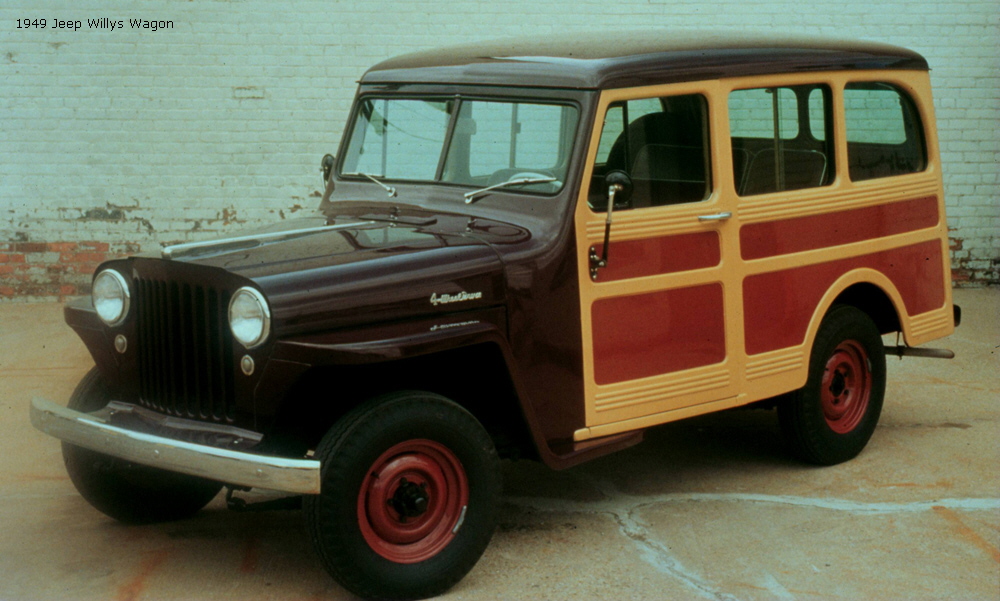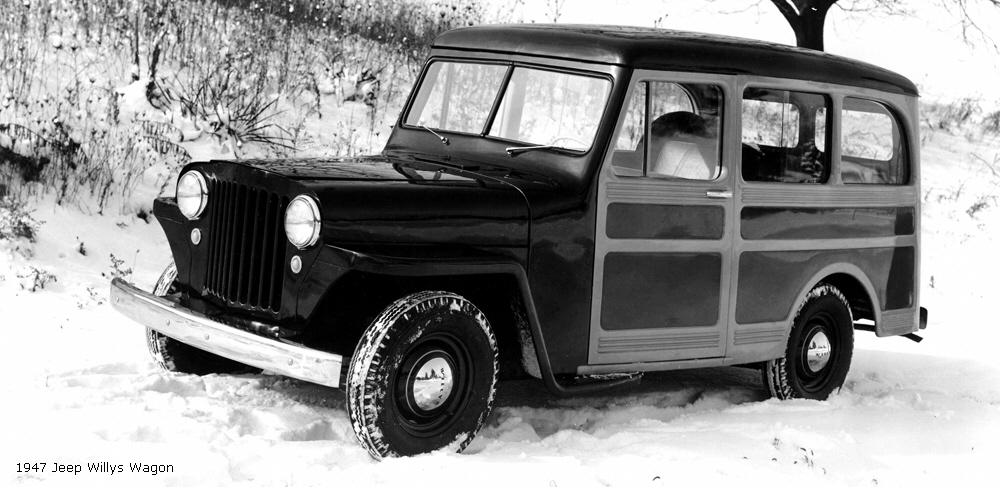
Combining a spacious interior with a low-maintenance exterior and four-wheel drive capability
Since 1941, the Jeep name has symbolized a unique family of robust go-anywhere, do-anything vehicles, first developed for military use and, after 1945, continually adapted for a wide variety of civilian applications.
The Jeep Grand Cherokee traces its lineage to a major branch of that tree, beginning with the 1946 Jeep Station Wagon, manufactured by the Willys-Overland Motor Corporation. The 4×2 Jeep Station Wagon was notable for being the first all-steel wagon. It was powered by the famous “Go-Devil” engine used in the military Jeep vehicles. The Jeep Station Wagon was taller than today’s station wagons, with a height of 72.75 inches.
The 1949 Jeep Station Wagon landed in showrooms with a new grille – eight slots instead of the 10 slots on the ’46 model. The big news, however, was that 1949 was the first year for the four-wheel drive Jeep wagon.
Jeep Station Wagon
In 1940, the United States Army, monitoring mounting tensions in Europe, determined that it had immediate need for a new type of reconnaissance vehicle. The subsequent Army “scout car” program would see the vehicle we now know as the Jeep 4×4 devised in just three months; to build the production vehicle, 135 manufacturers were invited to bid for an initial $175,000 contract. But only three manufacturers participated in the program: Willys-Overland of Toledo, Ford Motor Company of Detroit and American Bantam of Butler, Pennsylvania. All three built prototype vehicles. The contract went to Willys-Overland, but the standardized MA and MB Jeep vehicles built by Willys for the Army under the initial 16,000-unit contract were considered “homogenized” vehicles containing the best features of all three prototypes.
As the war progressed and the capabilities of the Jeep became better known, Milwaukee-based industrial designer Brooks Stevens became sufficiently intrigued with its uniqueness to write a magazine article proposing a postwar line of Jeep-based passenger cars. Impressed, Willys-Overland chief engineer Delmar “Barney” Roos hired Stevens as a consultant, charging him with conceptualizing the basic forms of the Willys postwar product line. By 1943 Stevens was working on sketches for a new Willys passenger car.
Early in 1944, before the program had assumed formal structure, Roos summoned Stevens to Toledo for an emergency meeting. Manufacturing expert Charles Sorensen, known in the auto industry as “Cast-Iron Charlie,” had been hired from Ford to serve as Willys-Overland’s new president. Roos expected Sorensen to replace the Willys product development team, including himself and consultant Stevens, with Ford people. But, in their first meeting, Sorensen and Stevens quickly established a rapport that would evolve into a long friendship. Sorensen doubled the designer’s retainer and asked if he could stay in Toledo a few days longer. Stevens, elated by his newfound fortune, said that if necessary he could stay until spring.
In the product team meetings that immediately followed, Sorensen scrapped all plans for new Willys passenger cars, seeing greater opportunity in creating not only “civilian” versions of the military-based Jeep but also additional car- and truck-like vehicles from the same platform, vehicles that would appeal to a greater number of buyers and create incremental production volumes for the company. Stevens began sketching again, starting with the now-famous slatted grille and accompanying bug-eye headlights that immediately bespoke “Jeep” to millions.
His first concepts – for the vehicle that would become the Jeep Station Wagon – were technically limited by the realities of automotive manufacturing in the 1940s. Many car bodies were produced by suppliers like Briggs and Murray, companies that would be fully engaged in producing bodies for the Big Three at the end of the war. Willys was forced to go to sheet-metal stampers outside the auto industry, suppliers who could only produce a “draw,” the depth to which a press can push or fold a metal sheet, up to six inches. With this limitation, Stevens held the draw of his wagon’s roof to just under six inches and the body draw to two-and-a-half inches. His slab-sided, cream-and-brown design visually simulated the ash framing and mahogany paneling of competitors’ “woody” station wagons, but at a fraction of the cost. The all-steel construction eliminated the need for constant maintenance known to wood-framed wagons, including periodic revarnishing; the stamped indentations also stiffened the body structure, creating a sturdier and safer vehicle.
With the end of the war in sight, Willys-Overland began preparations for peacetime Jeep production. After testing a pilot model of the newly-refined military model (designated CJ-1, for “Civilian Jeep”) and a test-bed prototype (CJ-2), the production version, the CJ-2A Universal Jeep, appeared in the summer of 1945. Close behind on the Toledo assembly line came Brooks Stevens’ all-new Jeep Station Wagon – the first all-steel wagon to be manufactured and sold in America.
When it appeared in dealers’ showrooms in the summer of 1946, the Jeep Station Wagon was an immediate hit. Not only was it one of the first all-new postwar vehicles to be produced, it was attractive, affordable, and perhaps most importantly, utilitarian – a vehicle appealing to the eye and the pocketbook, yet useful for a wide variety of tasks. Its compact 104-inch wheelbase allowed it to be driven and parked almost anywhere, and yet its interior provided seating for seven, with all but the driver’s seat made removable for cargo-hauling. In fact, with the rear seats removed, 96 cubic feet of cargo capacity became available, and the 50-inch interior height permitted transportation of especially tall items, something unthinkable in most cars of the era. For the first time the station wagon, previously considered by many a near-luxury vehicle, was being produced as a striking, low-cost family car – and quickly accepted.
The Jeep Station Wagon was also ruggedly dependable. Roos had provided a front suspension that resembled the “planar” suspension he developed for Studebaker in the Thirties; it utilized a seven-leaf transverse spring rather than conventional coil springs. The powertrain featured the Willys four-cylinder “Go-Devil” engine, augmented in the 1948 model year by a Roos-designed six-cylinder “Lightning” engine. Even more significant was the introduction of four-wheel drive models in 1949, beginning an association of that technology and cargo-carrying passenger vehicles that has been a hallmark of the Jeep brand ever since.
Correctly described as “One of the most influential automobiles ever built,” the Jeep Station Wagon was produced through the early 1960s, then succeeded by the Jeep Wagoneer and subsequent Jeep sport-utility vehicles.

1949 Jeep Station Wagon
- Wheelbase:………………..104.5 in. (265 cm)
- Length:……………………..174.75 in. (444cm)
- Weight:…………………….3,150 lbs. (1,429 kg)
- Engine(one example):…….Inline L-head four-cylinder, Single overhead cam V-6
- Horsepower:………..63 hp 47 kw
- Displacement:………34.2 cu. in. 2.2 L
- Bore/Stroke:………..3.125 in. x 4.375 in. (7.9 cm x 11.1 cm)
- Compression ratio:….6:5:1
- Transmission:………………Three-speed manual with two-speed transfer case
- Suspension:………………..Front and rear longitudinal leaf springs, live front axle
- Brakes:………………………Front and rear drum, hydraulic
After a decade-and-a-half of production, the Jeep Station Wagon would be succeeded by the longer, lower and larger Jeep Wagoneer in 1963, the first four-wheel-drive vehicle offered with an optional automatic transmission. Design cues were used from the Jeep vehicles Willys Station Wagons (1946 to 1962).

1947 Jeep Station Wagon advertisement. Roominess, comfort and safety were all solid selling points for the Jeep Station Wagon.


You must be logged in to post a comment.